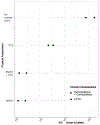Physical Performance Testing in Kidney Transplant Candidates at the Top of the Waitlist
- PMID: 32512039
- PMCID: PMC7686293
- DOI: 10.1053/j.ajkd.2020.04.009
Physical Performance Testing in Kidney Transplant Candidates at the Top of the Waitlist
Abstract
Rationale & objective: Frailty and poor physical function are associated with adverse kidney transplant outcomes, but how to incorporate this knowledge into clinical practice is uncertain. We studied the association between measured physical performance and clinical outcomes among patients on kidney transplant waitlists.
Study design: Prospective observational cohort study.
Setting & participants: We studied consecutive patients evaluated in our Transplant Readiness Assessment Clinic, a top-of-the-waitlist management program, from May 2017 through December 2018 (N=305). We incorporated physical performance testing, including the 6-minute walk test (6MWT) and the sit-to-stand (STS) test, into routine clinical assessments.
Exposures: 6MWT and STS test results.
Outcomes: The primary outcome was time to adverse waitlist outcomes (removal from waitlist or death); secondary outcomes were time to transplantation and time to death.
Analytical approach: We used linear regression to examine the relationship between clinical characteristics and physical performance test results. We used subdistribution hazards models to examine the association between physical performance test results and outcomes.
Results: Median 6MWT and STS results were 393 (IQR, 305-455) m and 17 (IQR, 12-21) repetitions, respectively. Clinical characteristics and Estimated Post-Transplant Survival scores accounted for only 14% to 21% of the variance in 6MWT/STS results. Physical performance test results were associated with adverse waitlist outcomes (adjusted subdistribution hazard ratio [sHR] of 1.42 [95% CI, 1.30-1.56] per 50-m lower 6MWT test result and 1.53 [95% CI, 1.33-1.75] per 5-repetition lower STS test result) and with transplantation (adjusted sHR of 0.80 [95% CI, 0.72-0.88] per 50-m lower 6MWT test result and 0.80 [95% CI, 0.71-0.89] per 5-repetition lower STS test result). Addition of either STS or 6MWT to survival models containing clinical characteristics enhanced fit (likelihood ratio test P<0.001).
Limitations: Single-center observational study. Other measures of global health status (eg, Fried Frailty Index or Short Physical Performance Battery) were not examined.
Conclusions: Among waitlisted kidney transplant candidates with high kidney allocation scores, standardized and easily performed physical performance test results are associated with waitlist outcomes and contain information beyond what is currently routinely collected in clinical practice.
Keywords: 6-minute walk test; Kidney transplantation; cardiorespiratory fitness; delisting; end-stage renal disease (ESRD); frailty; global health metric; mortality; physical performance; prehabilitation; risk stratification; sit-to-stand test; transplant candidate; transplant evaluation; transplant waitlist.
Copyright © 2020 The Authors. Published by Elsevier Inc. All rights reserved.
Conflict of interest statement
Financial Disclosure: The authors declare that they have no relevant financial interests.
Figures




References
Publication types
MeSH terms
Grants and funding
LinkOut - more resources
Full Text Sources
Medical

